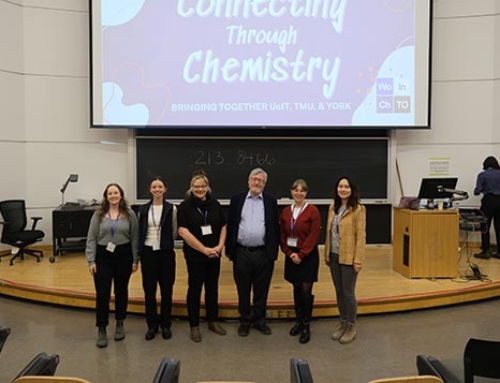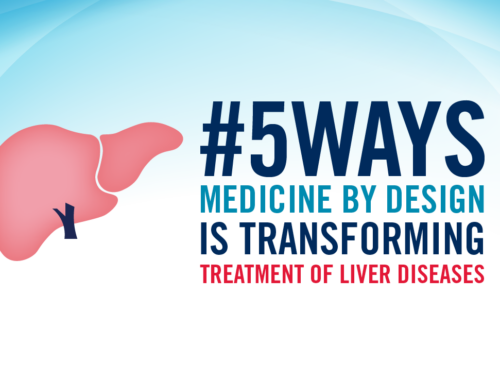
From left to right: Dr. Phyllis Billia, cardiologist, heart failure specialist, and director of research, Peter Munk Cardiac Centre, University Health Network; Sarah Crome, scientist, University Health Network; Omar F. Khan, assistant professor, University of Toronto; and Keith Pardee, associate professor, University of Toronto. (Photos of Sarah Crome, Omar F. Khan and Keith Pardee by Neil Ta. Photo of Phyllis Billia provided by the University Health Network).
Four researchers are the latest to receive support to spin-off aspects of their Medicine by Design-funded research into an early-stage product or venture as part of Medicine by Design’s Pivotal Experiment Fund, which has distributed more than $2.5-million in funding since its launch in early 2021.
“We are excited to add four new innovative projects to the third round of funding under the Pivotal Experiment Fund program,” says Michael Sefton, scientific director of Medicine by Design. “Each of these projects will receive funding to advance their discovery into a real benefit for human health.”
The Pivotal Experiment fund is designed to bridge a critical gap in translational research funding, often known as the “valley of death.” While governments provide much of the funding for discovery-based research, the funding for commercialization often comes from capital investors or industry partners. These partners require in-depth proof of concept data that is outside the scope of the original government funding before they will invest.
“Researchers often don’t have a sustainable way to get from making an important discovery in the lab to developing a new product or spinning out a company because funding for that middle ground is scarce,” says Sefton, who is also a University Professor at the University of Toronto (U of T) in the Department of Chemical Engineering & Applied Chemistry and the Institute of Biomedical Engineering. “The Pivotal Experiment Fund is designed to accelerate new regenerative medicine-based products and companies and get them ready for investment.”
Medicine by Design’s Pivotal Experiment Fund was open to Medicine by Design investigators working on large team projects and to Medicine by Design New Investigators. In total, over three rounds, Medicine by Design has awarded this support to 10 teams across faculties and departments at U of T and its partner hospitals.
“Gap-funding programs such as the Pivotal Experiment Fund dedicate early-stage commercialization support to researchers and clinicians in our ecosystem and are vital to moving our technologies forward,” says Mark Taylor, director of commercialization at the University Health Network (UHN). “This is also an essential part of our commercialization philosophy at UHN, where incubation funds such as the Princess Margaret Cancer Centre’s Innovation Acceleration Fund bring our technologies to pivotal inflection points. We are excited to work with Medicine by Design to further advance the transformative regenerative medicine innovations born within our vibrant Toronto ecosystem.”
Funding decisions for the Pivotal Experiment Fund are shaped by an investment review committee of leaders largely from the venture finance community. Researchers supported by the Pivotal Experiment Fund, as well as all Medicine by Design-funded researchers, also receive support in pivotal experiment plan development and outreach to industry partners and the venture capital community through Medicine by Design’s Entrepreneur-in-Residence program.
A new way to treat disease at the genetic level
Biomedical engineer Omar F. Khan’s lab focuses on nanomaterials — very small chemical molecules that coordinate the delivery of information-carrying molecules in cells that silence, regulate, express or help edit genes of interest. Nanoparticles are made of nanomaterials that can deliver nucleic acids like RNA, which provides “instructions” that cells can read and follow.
In their Pivotal Experiment Fund research, the Khan lab is developing a new mRNA delivery platform and is showing proof of concept data that it can be deployed to create new vaccines against infectious disease, and also that it can be used to deliver treatments for non-infectious diseases by providing the instructions to correctly make a protein that was defective in the patient.
“An optimized nanoparticle has the potential to reprogram cells, differentiate stem cells, treat chronic diseases, prevent disease and clear infections,” says Khan, who joined the U of T faculty in 2020, in a recruitment supported by Medicine by Design.
Khan, who’s an assistant professor at the Institute of Biomedical Engineering and the Department of Immunology, U of T, and the Canada Research Chair in Nucleic Acid Therapeutics, says this platform could have several advantages over others commercially available (such as the one used for the COVID-19 vaccine) including not needing cold storage, making it more stable for shipping and using anywhere, and decreasing painful reactions because a lower dose is needed.
The technology will be the core of a new U of T spin-out, Azane Therapeutics, which will be commercializing the technology working with co-development partners.
In addition, Khan says the platform could be less costly and easier to scale than other similar platforms because it has a simple design and uses lower-cost goods in its development.
Nanomaterials are an example of a new level of sophistication in regenerative medicine, Khan says, and Medicine by Design has been instrumental in advancing these technologies.
“In this new era of regenerative medicine, we are going deeper. In addition to looking at cells, we are now controlling them on a fundamental genetic level. Medicine by Design has brought together a lot of researchers with different backgrounds, but similar goals, to regenerate and prevent disease. This Pivotal Experiment Fund support will help us to keep advancing that work to patient impact.“
A platform to monitor patients after solid organ transplant
Dr. Phyllis Billia aims to develop a simple, non-invasive and inexpensive blood test to monitor patients following receipt of a transplanted organ, helping to identify patients who should have further surveillance or intervention.
Adopting the test has the potential to save the healthcare system millions of dollars, Billia says, and to become a new standard of care for transplant patients.
After a person receives a transplanted organ, it can be rejected because of inflammation, which Billia says can begin in the blood.
Dr. Billia and her team looked at a cellular process called clonal hematopoiesis. Stem cells acquire genetic mutations as we age. Clonal hematopoiesis occurs when these mutated stem cells create new blood cells that have changes in their genetic code, giving them a growth advantage. As a result, new blood circulating within the body is in an inflamed state. Clonal hematopoiesis, according to research by Billia and her team, has been linked to whether patients with solid organ transplants will have poor outcomes.
“We think that, by developing a diagnostics platform that can identify clonal hematopoiesis in people who have had a transplant, we can predict when individuals may need more monitoring, and possibly medical intervention, post-transplant,” says Billia, who is a cardiologist, heart failure specialist, and director of research at the Peter Munk Cardiac Centre and co-director of the Peter Munk Cardiac Centre biobank at UHN.
Heart transplant patient data supporting this work show that there is an association between clonal hematopoiesis and an increased incidence of post-transplant complications including death.
Billia, who is also an associate professor in U of T’s Department of Medical Biophysics, says that this pivotal experiment plan takes the work Billia and others are doing on a large Medicine by Design team project and spins it off into the new application of monitoring transplant recipients, which has a clear unmet clinical need.
Billia is working with John Dick, senior scientist at Princess Margaret Cancer Centre at UHN. A second co-investigator, Sagi Abelson, scientist at the Ontario Institute for Cancer Research.
“Our Pivotal Experiment Fund work brings scientists and clinicians together, which will help lead us to our goal of translating science to improve patient care.”
A new immunotherapy for transplantation and autoimmune disease
Sarah Crome’s Pivotal Experiment Fund support will go towards testing a targeted immune-cell therapy that involves a subset of immune cells with anti-inflammatory properties, which she says could have applications for treating graft-vs-host disease and type 1 diabetes and transplantation.
“The societal benefit would be considerable – a better, more efficient therapy for autoimmune diseases and transplantation means improved quality of life and better long-term outcomes,” says Crome, who is a scientist at the Toronto General Hospital Research Institute and Ajmera Transplant Centre, UHN.
Crome’s main research focus is on understanding mechanisms of immune tolerance — in other words, the cells and molecules within the body that control whether the immune system chooses to attack something or instead decides it is safe and inhibits inflammatory immune responses.
With this knowledge, she says, researchers could potentially tweak the immune system to respond in a desired way. For example, people who receive transplants of cells, tissues or organs often deal with the immune system rejecting the transplant. Controlling the immune response could prevent transplant rejection and increase transplant success.
The immune cells Crome is especially interested in are called innate lymphoid cells (ILCs). The lab has developed ways to isolate protective subsets of these cells, and they hope to advance this therapy by comparing it to current standards of care in graft vs. host disease and type 1 diabetes.
“We know specific subsets of ILCs can inhibit inflammatory immune cells,” says Crome. “With the Pivotal Experiment Fund support, we will perform pre-clinical studies that will assess the effectiveness of harnessing these cells in cell therapies, and hopefully emerge with a foundation to a first-in-class approach that could be translated for the benefit of patients.”
If successful, ILCs are likely to be easier to manufacture than other tolerance-promoting immune cell therapies available due to some unique properties.
Crome is part of a large, Medicine by Design-funded team project. Juan-Carlos Zúñiga-Pflücker, professor and chair of U of T’s Department of Immunology and a senior scientist at Sunnybrook Research Institute, leads the team project and is a co-researcher with Crome on the Pivotal Experiment Fund project.
Crome, who is also an assistant professor in the Department of Immunology at U of T, joined UHN and the U of T faculty in a recruitment supported by Medicine by Design.
“Through the Pivotal Experiment Fund and other programs, Medicine by Design has helped me bridge my fundamental biology and immunology interests with my translational interest,” Crome says. “They build connections between people in diverse fields who can learn from each other’s expertise.”
An affordable and accessible method of cell manufacturing
Cell therapies have the promise to revolutionize human health, but they can be expensive to manufacture and complex to scale.
The process of making a cell therapy often involves culturing stem cells to differentiate them into the cell type of choice—for example, a heart cell or a liver cell— and the materials to do so are often expensive and difficult to work with.
Keith Pardee envisions a better way, using cell-free biology. And with funding he received from the Pivotal Experiment Fund, he hopes to improve access to these life-saving therapies.
In this work supported by the Pivotal Experiment Fund, the Pardee lab will focus on developing engineered antibodies that can promote the healthy expansion of cells and make cell therapies more effective, among other benefits. Pardee says this work could provide a lower cost method of cell manufacturing for therapies.
Pardee compares the cell-free technologies his lab pioneers to powdered, instant soup mix. His lab takes living ingredients, derived from cells, and freeze-dries them. When there is a need for protein reagents in the lab, a DNA program can be added to the freeze-dried mixture, along with water, to reactivate it.
“We build biotechnology platforms that allow people to take tools that are normally limited to big, well-resourced labs or hospitals into the world, so it allows us to decentralize healthcare or increase access for research or manufacturing,” says Pardee, who is an associate professor of drug development and disease diagnostics at U of T’s Leslie Dan Faculty of Pharmacy.
“We think there are many potential applications of this work,” Pardee says. “Our goal will be to ensure that antibodies generated by this project make it to market, contributing to the health and economy of Canadians.”
Pardee is a researcher on a large Medicine by Design team project and also received funding under Medicine by Design’s Grand Questions Program.
The Pardee lab began researching these technologies in 2018, after Pardee joined the U of T faculty in a recruitment supported by Medicine by Design. Pardee says the Pivotal Experiment Fund addresses a real need for scientists working on these cutting-edge technologies and strategies.
“As scientists, we don’t want our research to sit on the shelf in a journal. We want to translate our discoveries and technologies as quickly and efficiently as possible so they can benefit society,” says Pardee. “But researchers often face a gap between the research funding we receive from universities and governments and the significant private-sector investments that we need to bring new therapies and technologies to the people who need them. The Pivotal Experiment Fund is an innovative way to address that gap.”
About Medicine by Design
Medicine by Design builds on decades of made-in-Canada excellence in regenerative medicine dating back to the discovery of stem cells in the early 1960s by Toronto researchers James Till and Dr. Ernest McCulloch. Regenerative medicine uses stem cells to replace diseased tissues and organs, creating therapies in which cells are the biological product. It can also mean triggering stem cells that are already present in the human body to repair damaged tissues or to modulate immune responses. Increasingly, regenerative medicine researchers are using a stem cell lens to identify critical interactions or defects that prepare the ground for disease, paving the way for new approaches to preventing disease before it starts. Medicine by Design is made possible thanks in part to a $114-million grant from the Canada First Research Excellence Fund.






